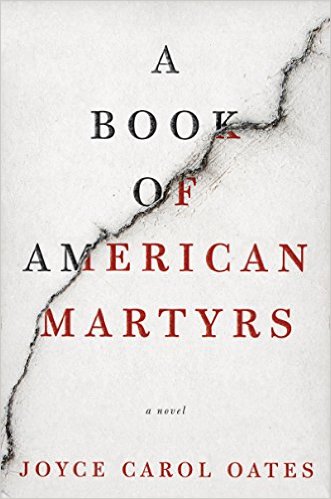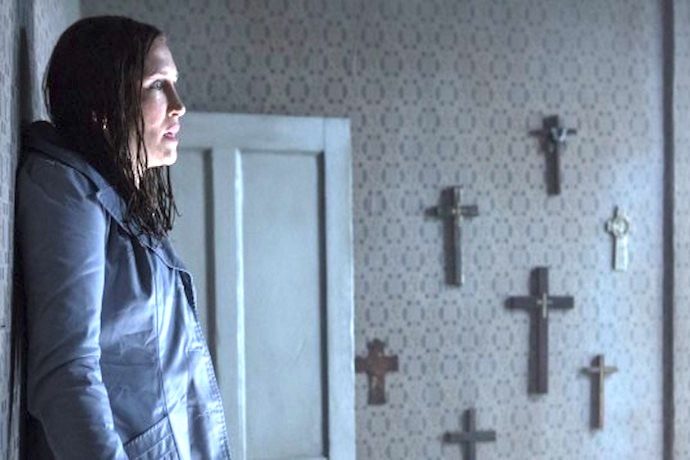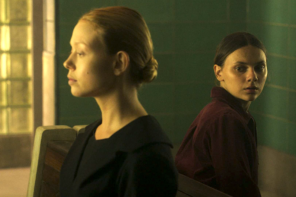Joyce Carol Oates’s hefty new novel, A Book of American Martyrs, reveals an America haunted by a mysterious, ultimately inexplicable force—religion—a force in eternal conflict not only with pluralism but ultimately with rationality itself.
The story concerns an array of characters affected by the murder of an ob-gyn who dedicated his late-career life to performing abortions. Published at a time of heightened polarization and amped-up rhetoric of violence (as well as violent acts), the book deserves attention as an empathetic attempt at exploring militant religious views while applying critical scrutiny to liberal blindness.
But in the end, Oates gives us something closer to genre fiction—yet another gothic horror story.

A Book of American Martyrs
Joyce Carol Oates
Ecco, February 2017
Religion, in Oates’s novel, is weird in the sense that H.P. Lovecraft’s tales are weird, or like Macbeth‘s “weird sisters” who prophesy doom. Religion, for Oates, appears here as a dark, intellectually inchoate force that motivates people with terror and toward violence, a source of fear but also of frightful strength. This is an odd, jarring—even baffling—way of conceptualizing the Christianity that is present in the discourse and practices of the explicitly religious people in this book.
At least two of the martyrs of the book’s title are an abortion doctor and his assassin. The first man, devoting his life to helping those in need of his services, knows that he risks his life. The second man, believing himself to be called by God to enact “justified homicide,” knows that his act will result in his own execution. The novel traces the ramifications, like cracks spreading across glass, of this murder. The narrative follows the daughters of each man, but also the widows left behind, the widow of the volunteer killed alongside the doctor, jurors and guards and executioners as well as various observers who function as a kind of virtual symposium—a tapestry of voices talking through various opinions on the issues of abortion and capital punishment.
The murdered doctor’s daughter decides in young adulthood to devote herself to a reconstruction of the events, to make a documentary film. The assassin’s daughter feels called by God to the world of professional female boxing. She, like her father, becomes the “Hammer of Jesus.”
The doctor’s daughter, Naomi, is privileged, educated, and politically liberal in an unexamined, kneejerk way. She is horrified by the violence of boxing, for instance. She serves as a kind of flawed stand-in for Oates-as-author, as she simultaneously pursues a parallel project to the novel’s plot—a large-scale examination of the aftershocks of one man’s murder. Paired with a default liberalism that not only jumps to judgment about others but then feels guilty about such judgment, holds views without having considering in depth the alternate argument and then feels guilty about that—well, as dramatic flaws go, this is something like a humblebrag, or like the kind of “weakness” ambitious young job applicants trot out for the stock interview question: “My biggest weakness? Probably caring too much.”
In contrast, the daughter of the murderer, Dawn, who calls herself DD, the Hammer of Jesus, is more like the sympathetic monster in a midnight movie. She is a species apart; her consciousness can never be fully plumbed. Her backstory slathers misfortune onto misfortune—including gang rape—in what feels like not only an attempt to explain her continued clinging to the lineaments of her faith but also reads, disturbingly, like the consequences of that faith.
The religious primitive lives always in a world defined by violence. When asked too many questions—by inquisitive, somewhat empathetic, liberal junior intellectual Naomi—DD breaks down, her tears the ultimate statement of her understanding of the divine. God makes her cry, makes her quiver, makes her punch other women. Her theology is visceral, the stuff of tears and sweat and blood, and she is incapable of thinking through issues such as whether Jesus also supports her opponents. Her way, after all, is religion, and religion here is the opposite of reason.
In a strong critique of the book in the New York Times, author Ayana Mathis notes that the stance of liberal-as-savior and the “dehumanizing caricature” at play in this novel is strikingly similar to liberal attitudes of superiority and dismissal seen in the recent election.
More the shame, for in this age of rekindled culture wars, of newly ubiquitous bomb threats and explicitly fascist posters on college campuses featuring swastikas and endorsements of violence, we needed not A Book of American Martyrs, but the book it could have been.
This is a resolutely political book—one that seems intent on representing and stimulating actual conversation across difference, highlighting logic and nuance across a spectrum of competing beliefs—about abortion, about capital punishment, about acts of terror (during the narrative, planes are flown into the Twin Towers by God-inspired men), about violence and death and life’s purpose. It is impossible not to begin reading this book without the expectation that it will be a big novel not merely in terms of length but in depth and range.
It seems, again, particularly weird that the issue around which Oates would construct a story of religion’s essential incommensurableness would be abortion. Handling serpents, faith healing, plural wives, sacramental psychedelics—all of these seem more likely (if likewise well-trodden) territory for Oates’s purposes. Instead, however, she focuses on the claim that the fetus (at least in some stages of development) is a human life, worthy of protection. This does not, on its face, seem an irrational, or by any means an incomprehensible, claim. Anti-abortion activists (and, in a separate scene, school age pranksters) unearth fetal remains from the trash bins behind a clinic. Inside boxes are bags with contents
fleshy, meat-colored, damp with blood. You could see the tiny curved legs, the tiny fingers and toes, the misshaped head. You could see the eyes that appeared large and were tight shut. You could see the miniature pouting mouth, that had never cried.
This is a moving scene, regardless of your beliefs about life’s beginnings or limits, regardless, surely, of your political ideology. Inside those bags are the moral question, or, to put it another way, how one interprets the contents of those bags, along a spectrum marked by the extremes of medical waste and tiny murdered humans, maps onto how one understands the question of abortion.
Would that Oates would have lingered on this, the open wound of the question, the destabilizing mystery. Instead, voices of characters take over. This is, after all, a novel of talk. And half the talk speaks in a register simplified to mimic the voices—already caricatures, already a kind of minstrelsy—familiar from the Jerry Springer Show. “Of course they lived! They were all alive, in their mother’s wombs. As you were alive, before you were born,” one woman insists, her language contradictory, blunt yet inexact. Young Dawn reflects that “Jesus had urged her daddy to shoot the baby killers with his shotgun but now (it seemed) Jesus had abandoned Daddy in the Broome County Men’s Detention Center where they could visit him for just one hour once a week on Saturdays.” For a character who will come to eschew coherent theology, she delineates contradictions quite clearly as a child, as if educational opportunities could have lifted her up from both her circumstances and her soteriology. As for her father, “His soul was secure within him like the liquid bubble in a carpenter’s level,” and he spends the days
signing copies of the New Testament through the day, slowly and with care, imagining the young Christian boys and girls to whom the book would be given, and how they would see his name as they opened the books, and began to read…
To read like automatons, surely, mindlessly, clinging to an otherwise compelling faith stance.
Liberal attitudes get skewered best by the traditional devil’s advocate of liberal intellectualism, a leftist curmudgeon, in this case an old, wheelchair bound professor who rolls in from central casting with a cigarette and a short term memory deficit. He drops bon mots in the major romance languages, criticizes the critics in the paper of record, and in one line links abortion to the Third Reich—yet later returns in calmer form to play another traditional role, that of the old professor in the horror movie who tells the young heroine about the true, terrible history of the place (ballet school, house, or country) in which she now resides:
There is a war in the United States—there has always been this war. Those of us who are rationalists can never win for there is a stronger more primordial and more spiteful will to American irrationality. What is it—‘my country right or wrong’—that sick, servile patriotism. All that patriotism is God-ism, for they are all Christians. All we can hope for is to prevent a total defeat. Pockets of relative enlightenment across the country—the larger cities, where people of education and intelligence have clustered. The rest if a vast wasteland—‘religious’ and ‘patriotic.’ You venture into it at your own peril—so many of them are armed!
This melodramatic pronouncement, while merely one voice in a novel of voices, nonetheless reads as the normative stance, identifying the horror that is the book’s prime concern—“slaughter of the innocents” not in the “pro-life” sense of the unborn but in the sense of “collateral damage” from a real war between darkness and light, faith and knowledge, religion and civilization.
The end—spoiler alert—may or may not hint at something like connection, even communication, between Naomi and DD, but it is hard to find much reason to be hopeful about this. It may well be transformative for Naomi, who is already struggling against her opinion of DD as naïve and “pathetic” and already castigating herself, surely, for her shock when DD failed to recognize the brand name Starbucks. But for DD, what can come of this encounter? Conversion, the mythic kiss that somehow transformers her from her monstrous self—the primitive, Christian other—to something socializable in the liberal world? Night classes, some NPR during her commute, maybe a trip to the Unitarians to ween herself from faith? Trade boxing for yoga?
But there is no sense, from this novel, that that other side, “the primordial and more spiteful” America of irrationality can ever change. It will exist as long as religion exists. And that, as a takeaway, is hardly useful in today’s needful political climate. Nor, for those of us who seriously consider lived religion, does it represent real understanding.





